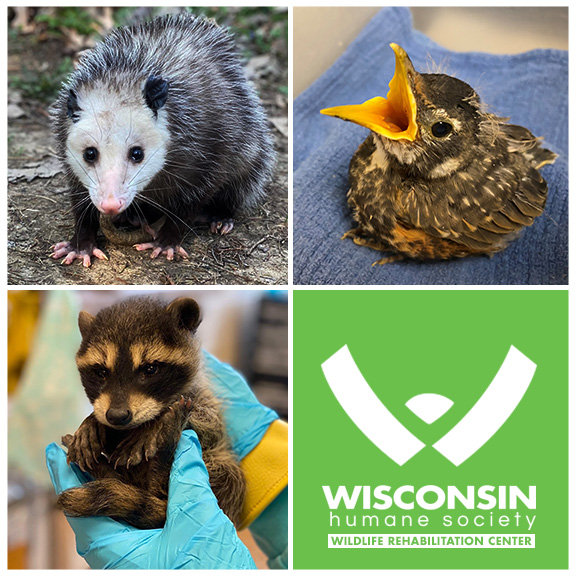Baby Squirrel
Click here for a print-friendly version.
Situation: 
You've found a young squirrel that you think might be orphaned.
Why This Happens:
Nestling squirrels are naked or sparsely furred; their eyes may not have opened yet, or their eyes may have just recently opened; their tails are not bushy and they can't hold their tail up over their back. These little ones sometimes get blown out of their nest of fall when a predator attacks their nest.
Juvenile Squirrels are fully-furred, have their eyes open and have a bushy tail. Juveniles are inexperienced and sometimes roam around exploring while their mother is away foraging for food. Due to their inexperience, they often approach people or other animals and seem quite tame or oblivious to danger.
FAQs & Humane Solutions:
“I found a young squirrel on the ground that still has its eyes closed. What should I do?”
There is a good chance the mother will find the baby and return him to the nest if you place him where his mother can find him. More about that later, but first, check the squirrel for injuries such as a bloody nose, bruising, cuts, or fly eggs (fly eggs look like clumps of mini rice grains, usually on furred areas of the body), or maggots (short, plump grub-like fly larvae, usually in wounds or the rectum). Also check to see if the squirrel is cool or cold to your touch. If the squirrel is injured or has fly eggs or maggots on it, it will need the attention of a licensed wildlife rehabilitator if it is to survive.
If you found the squirrel in Milwaukee County, you may call us at (414) 431-6204 for advice about bringing the squirrel to us for care. If you are outside of Milwaukee County, call your local licensed wildlife rehabilitator.
If the squirrel feels cool to the touch, it should be warmed before trying to reunite it with its mother. Contrary to popular belief, the mother squirrel will NOT reject the baby because it has been handled by humans, but she may reject the youngster if it is cold and lethargic. The baby squirrel can be warmed by placing it on a zipper-top plastic bag that has been partially filled with very warm water. The water should be very warm (~105°F), but not scalding hot. Cover the plastic bag with a clean, ravel-free (no loose strings or loops that could entangle the baby) cloth and place the squirrel on top of the cloth-covered bag to warm him. Cover the baby with a single layer of ravel-free cloth to help conceal it from predators and to help keep it warm.
To reunite a warm, healthy squirrel with its mother, place the squirrel in a shallow cardboard box on a warm water bag as described above. Put the box at the base of the tree that contained the nest. This should be done ONLY during daylight hours. Gray, Red, and Fox Squirrels are active during daylight hours, so the mom squirrel will not find them at night, but a roaming predator might, so do NOT leave it out overnight! Do not put food or a dish of water in the box: the food could attract predators and the squirrel could become wet and cold, or even drown in the dish of water. Keep an eye on the young squirrel from indoors so your presence doesn't scare the mother squirrel and keep her from returning. Be on the lookout for possible predators such as cats and crows. If, after a couple of hours, the mother hasn't retrieved the baby, call the WHS Wildlife Rehabilitation Center at (414) 431-6204 or your local licensed wildlife rehabilitator for further advice.
“I found a juvenile squirrel on the ground. She doesn’t seem to be injured. What should I do?”
If the squirrel appears to be healthy (you don’t see any injuries, no bloody nose, fly eggs, or maggots and she seems alert and active), you should observe the squirrel from a distance, preferably from indoors, to see if its mother shows up to take care of it. If you want to provide the young squirrel with additional protection while you wait, you can place the youngster in an open-topped box. The sides of the box should be high enough that the young squirrel can’t climb out but low enough for Mom to get in. The box should contain some bedding material like a clean cloth that does not have any loose loops or strings on it (which may entangle the squirrel), or use DRY, natural leaf-litter.
Caution: if it is frightened, an older juvenile squirrel may bite if it is picked up by hand. To protect against being bitten, either gently scoop the squirrel into a box or use a piece of cardboard or a plastic cup or a shovel to GENTLY scoop it up and place it in a box. We recommend you wear a pair of leather work gloves when you scoop up the squirrel. Be sure to wash your hands with soap and water after handling the squirrel, even if you had gloves on and did not touch the squirrel.
Keep an eye on the young squirrel for a couple of hours from indoors so your presence doesn't prevent the mother from returning. As the water in the zip-top bag begins to cool you’ll need to replace it with warm water to keep the baby warm. Be on the lookout for possible predators such as cats and crows. If, after a couple of hours the mother hasn't retrieved the baby, call the WHS Wildlife Rehabilitation Center at (414) 431-6204 or your local licensed wildlife rehabilitator for further advice.
“What do I do if I find an injured baby squirrel (bloody nose or other apparent injury)?”
If you find an injured baby squirrel and you want to help it, place it in a box with a soft, ravel-free (no loose strings or string loops) towel (see handling instructions above). Do not offer it food or water; just keep it warm in a safe, quiet location, away from children and pets. If you are in Milwaukee County, call the WHS Wildlife Rehabilitation Center at (414) 431-6204 for advice. If outside of Milwaukee County, call your local licensed wildlife rehabilitator for further advice.
“I’m concerned that while I try to get the squirrel reunited with its mother, it might become injured or be killed by a car or a predator. Why shouldn't I bring it straight to you so you can raise it?”
As a non-profit organization, our limited resources must be reserved for animals who are truly orphaned and require human intervention to survive. While we do a great job of raising orphaned squirrels, a young squirrel’s mother will ultimately teach it many lessons that will help the youngster survive. These lessons include recognizing and avoiding predators, finding shelter, finding, storing and processing food in different seasons, and much more. Most young wild animals that people find are not really orphaned. Their parent(s) are usually nearby and will continue caring for their babies if given the chance.
.jpg)

.png)

